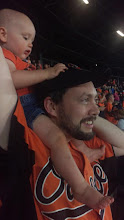
Here's a two-for-one to make up for my recent inactivity. How do you suppose you would pronounce Aurelio's last name? MON-tay-ah-GOO-doe?
Fun facts about Jim Dickson:-Hailing from Portland, OR, Jim signed with the Pirates in 1958 at age 20.
-He pitched in the Pittsburgh farm system for four years, never surpassing class A ball.
-After compiling a 10-4 record and 3.02 ERA at B-level Burlington in 1961, he was claimed by Houston in the minor league draft.
-Jim debuted with the Colt .45s in July of 1963. He was knocked around a bit in 13 games, but did notch two saves. His first came on
July 5, as he induced a Del Crandall ground ball to strand the tying runs on base in the eighth inning and stayed on for a 1-2-3 ninth.
-Was traded to Cincinnati the following year, but pitched only four times for the Reds and was claimed by the Athletics the next offseason in the Rule V draft.
-The A's called on Jim often in 1965, as his 68 appearances ranked fourth in the league and set an AL rookie record. He performed well, compiling a 3.47 ERA that was among the lowest on the team.
-Had a 12-game streak without allowing an earned run in 1966, but was hit hard that summer and sent to the minors with a 5.35 ERA. He would hang around at AAA through the 1970 season without ever being recalled to the majors.
-In parts of four big league seasons, Dickson was 5-3 with a 4.36 ERA and three saves.
Fun facts about Aurelio Monteagudo:-Born in Cuba, Aurelio later became a Venezuelan citizen after Fidel Castro rose to power in his native land. He was signed by the A's in 1961 at age 18.
-His father Rene was a pitcher and outfielder for the Senators and Phillies during the World War II years.
-Aurelio debuted with Kansas City in September of 1963, allowing two runs in seven innings over four relief appearances.
-He traveled often and pitched sparingly in his major league career. From 1963-1967 he appeared in only 36 total games for three clubs (A's, Astros, White Sox).
-Monteagudo didn't resurface in the majors until 1970, when he put up a 2.96 ERA and a 1.06 WHIP for the Royals in 21 games. He also collected his first win in the
June 15 game, when he retired the only batter he faced to end the top of the ninth and then benefited from a three-run comeback by Kansas City in the bottom of the inning!
-It took another three years for Aurelio to get his next shot in the bigs, a second-half stint with the Angels in 1973. He saw action in 15 games to close the book on his MLB career.
-In parts of seven seasons he was 3-7 with a 5.05 ERA and four saves.
-His signature pitch was a screwball, which he used to great effect in a 20-year run in the Venezuelan winter league. He was 79-81 with a 3.37 ERA.
-Monteagudo also pitched in the Mexican league, leading in strikeouts with 222 in 1978 and tossing a no-hitter in 1979.
-In 1990, his life came to a tragic end when he was in a fatal car accident in Mexico. He was 46 at the time of his death. Eerily, the only other two players in major league history who were named Aurelio (third baseman Rodriguez and pitcher Lopez) also met a premature demise in auto accidents in the ensuing decade. More details
at my other blog.


